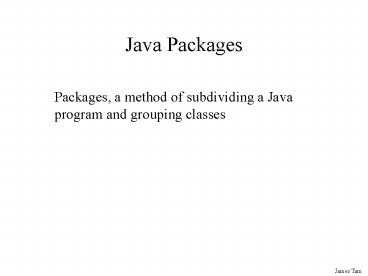Java Packages - PowerPoint PPT Presentation
1 / 25
Title:
Java Packages
Description:
... definition you must indicate the package that the class belongs to. ... Alternatively it could be based on your email address. e.g., tamj_at_cpsc.ucalgary.ca ... – PowerPoint PPT presentation
Number of Views:193
Avg rating:3.0/5.0
Title: Java Packages
1
Java Packages
- Packages, a method of subdividing a Java program
and grouping classes
2
Packages
- A collection of related classes that are bundled
together - Used to avoid naming conflicts for classes
- Also it allows for only some implementation
details to be exposed to other classes in the
package (only some classes can be instantiated
outside of the package)
org.omg.CORBA
java.lang
Object
Object
Exception
Error
StringBuffer
System
String
3
Fully Qualified Names
package name
- pack3.OpenFoo.toString()
class name
method name
4
Importing Packages
- Importing all classes from a package
- Format
- import ltpackage namegt.
- Example
- import java.util.
- Importing a single class from a package
- Format
- import ltpackage namegt.ltclass namegt
- Example
- import java.util.Vector
5
Importing Packages (2)
- When you do not need an import statement
- When you are using the classes in the java.lang
package. - You do not need an import statement in order to
use classes which are part of the same package
6
Default Package
- If you do not use a package statement then the
class implicitly becomes part of a default
package - All classes which reside in the same directory
are part of the default package for that program.
7
Fully Qualified Names Matches Directory Structure
- pack3.OpenFoo.toString()
home
package name
233
class name
examples
method name
packages
packageExample
pack3
OpenFoo.java
ClosedFoo.java
8
Where To Match Classes To Packages
- In directory structure The classes that belong
to a package must reside in the directory with
the same name as the package (previous slide). - In the classes source code At the top class
definition you must indicate the package that the
class belongs to. - Format
- package ltpackage namegt
- ltvisibility public or packagegt class ltclass
namegt
9
Matching Classes To Packages (2)
- Example
- package pack3
- public class OpenFoo
- package pack3
- class ClosedFoo
10
Matching Classes To Packages (2)
- Example
- package pack3
- public class OpenFoo
- package pack3
- class ClosedFoo
11
Suns Naming Conventions For Packages
- Based on Internet domains (registered web
addresses) - e.g., www.tamj.com
.games
.productivity
12
Suns Naming Conventions For Packages
- Alternatively it could be based on your email
address - e.g., tamj_at_cpsc.ucalgary.ca
.games
.productivity
13
Graphically Representing Packages In UML
Package name
Classes visible outside the package
-Classes not visible outside the package
(protected class)
14
Packages An Example
- The complete example can be found in the
directory - /home/233/examples/packages/packageExample
- (But you should have guessed the path from the
package name)
packageExample
pack1
pack2
pack3
Driver
IntegerWrapper
IntegerWrapper
ClosedFoo
OpenFoo
15
Graphical Representation Of The Example
pack1
IntegerWrapper
(Unnamed)
pack2
-Driver
IntegerWrapper
pack3
OpenFoo -ClosedFoo
16
Package Example The Driver Class
- import pack3.
- class Driver
- public static void main (String argv)
- pack1.IntegerWrapper iw1 new
pack1.IntegerWrapper () - pack2.IntegerWrapper iw2 new
pack2.IntegerWrapper () - System.out.println(iw1)
- System.out.println(iw2)
- OpenFoo of new OpenFoo ()
- System.out.println(of)
- of.manipulateFoo()
17
Package Example Package Pack1, Class
IntegerWrapper
- package pack1
- public class IntegerWrapper
- private int num
- public IntegerWrapper ()
- num (int) (Math.random() 10)
- public IntegerWrapper (int newValue)
- num newValue
- public void setNum (int newValue)
- num newValue
18
Package Example Package Pack1, Class
IntegerWrapper (2)
- public int getNum ()
- return num
- public String toString ()
- String s new String ()
- s s num
- return s
19
Package Example Package Pack2, Class
IntegerWrapper
- package pack2
- public class IntegerWrapper
- private int num
- public IntegerWrapper ()
- num (int) (Math.random() 100)
- public IntegerWrapper (int newValue)
- num newValue
- public void setNum (int newValue)
- num newValue
20
Package Example Package Pack2, Class
IntegerWrapper (2)
- public int getNum ()
- return num
- public String toString ()
- String s new String ()
- s s num
- return s
21
Package Example Package Pack3, Class OpenFoo
- package pack3
- public class OpenFoo
- private boolean bool
- public OpenFoo () bool true
- public void manipulateFoo ()
- ClosedFoo cf new ClosedFoo ()
- System.out.println(cf)
- public boolean getBool () return bool
- public void setBool (boolean newValue) bool
newValue - public String toString ()
- String s new String ()
- s s bool
- return s
22
Package Example Package Pack3, Class ClosedFoo
- package pack3
- class ClosedFoo
- private boolean bool
- public ClosedFoo () bool false
- public boolean getBool () return bool
- public void setBool (boolean newValue) bool
newValue - public String toString ()
- String s new String ()
- s s bool
- return s
23
Updated Levels Of Access Permissions Attributes
And Methods
- Private -
- Can only access the attribute/method in the
methods of the class where its originally
defined. - Protected
- Can access the attribute/method in the methods of
the class where its originally defined or the
subclasses of that class. - Package - no UML symbol for this permission level
- Can access the attribute/method from the methods
of the classes within the same package - If the level of access is unspecified in a class
definition this is the default level of access - Public
- Can access attribute/method anywhere in the
program
24
Updated Levels Of Access Permissions
25
You Should Now Know
- How packages work in Java
- How to utilize the code in pre-defined packages
- How to create your own packages
- How the 4 levels of access permission work































